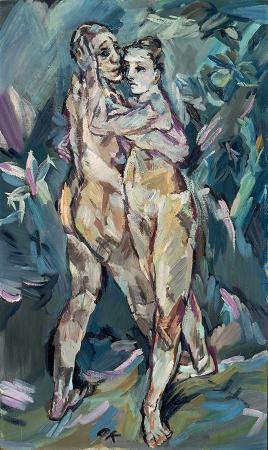Oskar Kokoschka (1886 - 1980). Oskar Kokoschka was an Austrian artist, poet and playwright best known for his intense expressionistic portraits and landscapes. The second child of Gustav Josef Kokoschka, a Bohemian goldsmith, and Maria Romana Kokoschka, Oskar Kokoschka was born in Pöchlarn. His older brother died in infancy. His sister, Berta was born in 1889; and a brother, Bohuslav, in 1892. Oskar had a strong belief in omens, spurred by a story of a fire breaking out in Pöchlarn shortly after his mother gave birth to him. The family's life was not easy, largely due to a lack of financial stability of his father. They constantly moved into smaller flats, farther and farther from the thriving centre of the town. Concluding that his father was inadequate, Kokoschka drew closer to his mother; and seeing himself as the head of the household, he continued to support his family when he gained financial independence. Kokoschka entered a Realschule, a type of secondary school, where emphasis was placed on the study of modern subjects such as the sciences and language. Kokoschka was not interested in such subjects, as he only excelled in art, and spent most of his time reading classic literature during his lessons. One of Kokoschka's teachers suggested he pursue a career in the fine arts. Against his father's will, Kokoschka applied to the Kunstgewerbeschule in Vienna, now the University of Applied Arts Vienna. He was one of three applicants accepted of 153. The Vienna Kunstgewerbeschule was a progressive school of applied arts that focused mainly on architecture, furniture, crafts and modern design. Unlike the more prestigious and traditional Academy of Fine Arts Vienna, the Kunstgewerbeschule was dominated by instructors of the Vienna Secession. Kokoschka studied there from 1904 to 1909, and was influenced by his teacher Carl Otto Czeschka in developing an original style. Among Kokoschka's early works were gesture drawings of children, which portrayed them as awkward and corpse-like. Kokoschka had no formal training in painting and so approached the medium without regard to the traditional or correct way to paint. The teachers at the Kunstgewerbeschule helped Kokoschka gain opportunities through the Wiener Werkstätte or Viennese Workshops. Kokoschka's first commissions were postcards and drawings for children. Later, Kokoschka said that this exercise provided the basis of artistic training. His early career was marked by portraits of Viennese celebrities, painted in a nervously animated style. Kokoschka had a passionate, often stormy affair with Alma Mahler. It began in 1912, five years after the death of her four-year-old daughter Maria Mahler and two years after her affair with Walter Gropius, later a celebrated architect in Berlin. But after several years together, Alma rejected him, explaining that she was afraid of being too overcome with passion. He continued to love her his entire life, and one of his most acclaimed works, The Bride of the Wind, is expressive of their relationship. The poet Georg Trakl visited the studio while Kokoschka was painting this masterpiece. Kokoschka's poem Allos Makar was inspired by this relationship. He volunteered for service as a cavalryman in the Austrian army in World War I, and in 1915 was seriously wounded. At the hospital, the doctors decided that he was mentally unstable. Nevertheless, he continued to develop his career as an artist, traveling across Europe and painting the landscape. He commissioned a life-sized female doll in 1918. Although intended to simulate Alma and receive his affection, the 'Alma doll' did not satisfy Kokoschka and he destroyed it during a party. In May 1922 he attended the International Congress of Progressive Artists and signed the Founding Proclamation of the Union of Progressive International Artists. Deemed a degenerate by the Nazis, Kokoschka fled Austria in 1934 for Prague. In Prague his name was adopted by a group of other expatriate artists, the Oskar-Kokoschka-Bund, though Kokoschka declined participation with their group. In 1938, when the Czechs began to mobilize for the expected invasion of the Wehrmacht, he fled to the United Kingdom and remained there during the war. With the help of the British Committee for Refugees from Czechoslovakia, all members of the OKB were able to escape through Poland and Sweden. During World War II, Kokoschka painted anti-Fascist works such as the allegory What We Are Fighting For. During several summer months, he and his young wife, Oldriska Olda Palkovská Kokoschka, lived in Ullapool, a village in Wester Ross, Scotland. There he drew with coloured pencil, and painted many local landscape views in watercolour.
more...













